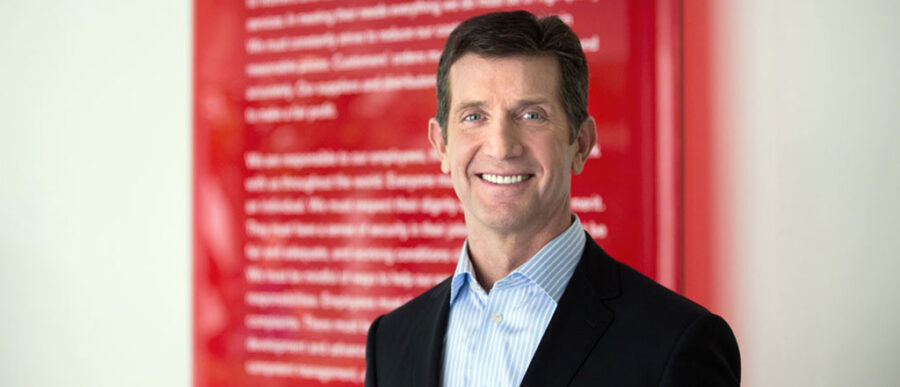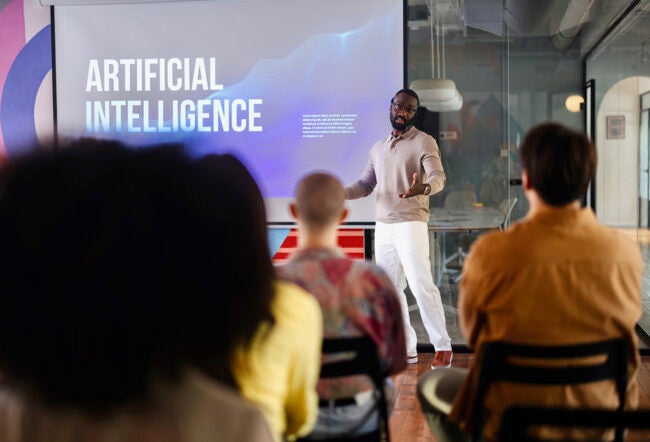Alex Gorsky, a 26-year veteran of Johnson & Johnson, was appointed chairman and CEO of J&J in 2012. The New Brunswick, N.J.-based health care enterprise has close to 130,000 employees, revenues of approximately $70 billion and more than 250 operating companies around the world. Gorsky discusses his leadership style, approach to decision making and common leadership myths during a recent interview with Wharton management professors Michael Useem and Adam Grant.
An edited transcript of the conversation follows.
Michael Useem: Alex, welcome. I am going to start with a question about the toughest decision that you have made in the last year or so. Describe that decision: What were the conflicting concerns and then how did you work it through, given the fact that you lead a rather large company?
Alex Gorsky: Fortunately or unfortunately during my career, I have had a chance to take part in some pretty significant decisions along the way, be it strategic, business or operational. But I’ve got to say I think some of the most challenging, and probably the most challenging, have been related to very significant organizational and people changes within our company, particularly when you know this is something that can impact employees’ future, that can affect families. Those are things that you always want to do with a lot of thought, with a lot of care and a lot of empathy. Those types of decisions for me personally have always been some of the most challenging.
There are a few things that we try to do. Obviously the first is make sure that you’ve got the right team around you. So many of the decisions that ultimately wind their way to me have, by and large, been decided by a great group of leaders who have a tremendous amount of responsibility in terms of their businesses and the organizations that they represent.
Second, it’s to make sure that as you’re going through and making those decisions, you provide an atmosphere where you can really have debate, where you can really have challenge, where there’s not just a pre-ordained recommendation – and, frankly, where one plus one can equal four or five in the whole decision making process. I’ve always found that encouraging a diversity of opinion by different members, sometimes even challenging people to come in and argue the opposite of the direction that we’re heading in, really makes sure that you have thought through the implications.
Last but not least, it’s once you’ve made that decision — recognizing that there’s going to be different points of view – then getting full alignment around your leadership team so that you’re speaking in one voice and in a common direction. That’s what I’ve seen be one of the biggest challenges, but that’s the way that we tried to deal with it — to make sure that we’re ultimately making the best decisions for the company and all our stakeholders.
Adam Grant: Alex, is there an example that stands out, particularly when it comes to challenging people to bring different opinions or maybe even argue for the opposite of what they believe? Were you able to stimulate that, and did it have a positive effect?
Gorsky: I’ve had a number [of examples] along the way. But I think one in particular stands out for me related to one of our products where we were making a specific recommendation about it on the market. There was a lot of pressure tied to the issue. Right before we made that decision, I remember calling our chief counsel that night and saying: “I’d like you to talk to a law firm and actually have them argue the opposite point of view.” So, we went outside the company…. What I found through that process was that we ended up staying with the right decision. But taking that pause made sure that we had much more confidence and conviction in our position…. Yes, you want to be a decision [maker], but you also have got to realize the impact that your decisions can have. I think taking that extra moment, having that extra challenge, is good practice.
Useem: Alex, you came out of the U.S. Military Academy at West Point, and took a job pretty much at the ground level in a unit at Johnson & Johnson. In your first job, as I recall, you led nobody, you were pretty much on your own. But you moved up to 30 [employees], 300, 3,000 and now 130,000. How have you had to change your leadership style going from nobody to a few, then a lot and now over 100,000? How has your thinking about leadership evolved? What’s different now from the way you would have led say, 10 years ago, in the way you operate?
Gorsky: Your leadership does need to evolve as you move through an organization. I think there are a lot of lessons that you learn along the way. Number one is learning the importance of, “It’s not really what I do but it’s about what the people who you work with do,” and working through others. I think that’s one of the biggest challenges facing you — just learning that skill where you’re no longer the individual contributor but you’re contributing by bringing together a group of people who have different skills, different capabilities and working through them to accomplish a particular task. I see that as being a significant challenge facing many leaders as they move through an organization. That was certainly one for me.
The second one is understanding the global impact of your decision when you’re starting in one particular area and have a rather local impact, to today where every decision you make can have an impact globally — from Mumbai to Minneapolis, from Warsaw to Miami. And always considering what that true global impact of a particular decision can be.
Last but not least, it’s about always trying to predict what the strategic implications are. So, what are the second or third order consequences of a particular decision versus the immediate impact? Johnson & Johnson fortunately is a company that has been around for over 126 years. I’m always trying to think about, “What is it over the next 10 years?” — not the next just one year or two years. Certainly there’s always an issue du jour that we’re working on. But I’m trying to think about what are the decisions that we can make, what are the directions we can go in, that are going to continue our track record and sustainability for the next decade, for the next 100 years.
“Encouraging a diversity of opinion by different members … makes sure that you have thought through the implications.”
Grant: Alex, you’re known not only as someone who cares a lot about developing leaders but also about your leaders developing leaders below them. How do you figure out one, who those people are who are likely to be good at leadership development and two, what do you actually teach them?
Gorsky: That’s a great question. I do believe that one of the best indicators of leadership is a leader’s track record in developing leaders. I will frequently focus on three areas when I’m interviewing or when I’m talking to people. One is certainly on performance because you always want to have leaders who are committed to high performance and … handling a wide range of different scenarios.
Second, I always focus on what’s their track record of developing future leaders. One of my favorite questions is to ask people is, “If I asked you who had the biggest impact on your career and how they did that, who are those four people that you would name?” At a senior level, if they can’t name three or four fairly senior level people, then immediately I question their wherewithal in people development.
“People are not looking for a perfect leader. They want a leader who cares about them and is going to help them try to be better.”
Last, I’ll ask how do they move their businesses, how do they develop talent with our credo in mind. It gives me an indication of how committed they are to developing individuals, to developing teams and frankly, figuring out how to work through others to get their jobs done.
Useem: At Johnson & Johnson, what do you think is the perception of leadership in general, maybe leadership in particular in your own experience, that turns out to be most incorrect? What do people looking at leaders often not see?
Gorsky: I think that one of the most significant myths about leadership is that the top leader is there to just make the decision versus taking much more of a service-oriented approach [knowing that] you are in service to many of those who are going to be impacted by your decision. I can tell you right now that I definitely approach the job from the latter [perspective], always trying to understand the consequences, the implications that your decisions are going to have on your different stakeholders, ranging from customers, the communities that you work in, your shareholders, your employees, all the people who might be touched, and learning that at the end of the day we’re really in service to them — that the jobs that we do … have got to ultimately be helping all of those stakeholders realize their objectives. I think frequently it’s not about the “boss” making a certain decision; it’s the decisions we make in service to those stakeholders that are really important.
Grant: Building on that, what is the success or accomplishment over your career that you’re most proud of?
Gorsky: The thing that I’m most proud of are the great leaders that I’ve had a chance to work with along the way who have gone on to take great positions of responsibility and, frankly, made a difference within J&J and of course in other areas as well. I’ve had the opportunity to work with a broad number of people through my several decades [at the firm]. Frankly, starting with my time in the military, and with my time as a coach with my son’s teams, to my time at Johnson & Johnson, and some time at New Artists as well, there’s nothing that gives me greater satisfaction than knowing that people have been able to go on and do a lot of good things for patients, for consumers, along the way. That [gives me] a great deal of satisfaction and, of course most importantly, just knowing that the products and the services that we’re offering every day hopefully are helping people live longer, healthier and happier lives. That’s a great sense of satisfaction.
“How do you make sure every day — when decisions are made in many different areas around the world and in different business organizations – that the credo remains our moral compass, the glue that holds us together?”
Useem: A question for people who are just coming into leadership responsibilities. Think about the first job where you had a responsibility for others. Think maybe even later on, but especially for those who are first taking on a significant leadership role. From your own experience, what are the one or two lines of advice that you’d like to pass on to them so they can get to where they want to go in taking on that leadership obligation?
Gorsky: A couple of things. One [is that] it’s really important for early leaders to be themselves. So often leaders get into a role and maybe have some ideal of what it is to be a leader. I think the most important thing that a new leader can have stepping into a role is humility, understanding that they’re going to learn, that they’re going to make mistakes, and to approach the scenario as something where they’re going to have to grow into [the position]. Having that kind of a mind-set will immediately endear the people who are working with you and around you. They’re not looking for a perfect leader. They want a leader who cares about them and is going to help them try to be better. I think as a new leader if you remember this, that they expect you to be human, that you’re going to make mistakes and that as long as you learn and care for the people who are working with you, I think that’s the most important thing you can do.
Useem: Quick final question on that…. You’ve got people all over the world, and thus the tone you set at the top, the culture, the ethics, the values become critical. Johnson & Johnson has a very famous credo, about 300 words that say, “We’re here on earth to serve people who need our products, great community, great employment setting and then we work for shareholders as well.” When I was in your headquarters a couple of years ago, I noticed that this credo is carved in stone on the main floor of headquarters. What happens if you want to change the credo?
Gorsky: Well, Mike, as you know, the credo … was written over 70 years ago by General Robert Wood Johnson himself. It’s been a great source of inspiration, and it does outline our responsibilities to our different stakeholders — all that you mentioned, [including] customers, employees, communities, as well as shareholders ultimately. And through the years, there have been a few times when it has been updated. But the core principles are something that we don’t think should change. As I stepped into this role, just as my predecessors, I think one of the first things we’ve always tried to do is reaffirm our commitment to those core principles embodied in that document.
Now I think what’s more important for us in the organization is how we bring that credo to life. How do you make sure every day — when decisions are made in many different areas around the world and in different business organizations – that the credo remains our moral compass, the glue that holds us together? That’s something that we constantly reinforce through town hall meetings, through outreach programs. In fact, this year is the 70th anniversary of our credo. We’re having a Credo Challenge Session where every board of the 250 companies that you mentioned earlier is challenging the relevance of our credo and going through it line by line. It’s by … keeping this alive in the organization — which we think is incredibly important – that we make sure we do the right thing.



